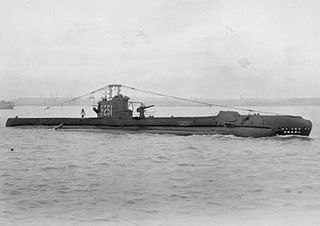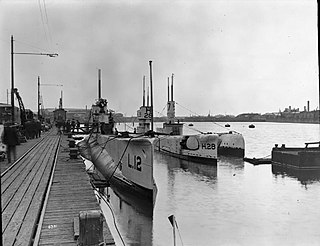
The Rainbow-class submarine or R class was a quartet of patrol submarines built for the Royal Navy in the early 1930s.

HMS L1 was the lead boat of the L-class submarines built for the Royal Navy during World War I.

HMS L4 was a L-class submarine built for the Royal Navy during World War I. The boat survived the war and was sold for scrap in 1934.

HMS L52 was a late-model L-class submarine built for the Royal Navy during the First World War. The boat was not completed before the end of the war and was sold for scrap in 1935.
HMS L54 was a late-model L-class submarine built for the Royal Navy during the First World War. The boat was not completed before the end of the war and was sold for scrap in 1939.

HMS Supreme was a S-class submarine of the third batch built for the Royal Navy during World War II. She survived the war and was sold for scrap in 1950.

HMS Subtle was a S-class submarine of the third batch built for the Royal Navy during World War II. She survived the war and was scrapped in 1959.
HMS L56 was a late-model L-class submarine built for the Royal Navy during the First World War. The boat was not completed before the end of the war and was sold for scrap in 1938.
HMS L69 was a late-model L-class submarine built for the Royal Navy during the First World War. The boat was not completed before the end of the war and was sold for scrap in 1939.

HMS L27 was a L-class submarine built for the Royal Navy during World War I. The boat was not completed before the end of the war and was one of three L-class boats to serve during World War II. She served as training boat before being broken up in 1944.

HMS L9 was an L-class submarine built for the Royal Navy during World War I. The boat survived the war and was sold for scrap in 1927.

HMS L12 was a L-class submarine built for the Royal Navy during World War I. She was one of five boats in the class to be fitted as a minelayer. The boat survived the war and was sold for scrap in 1932.
HMS L16 was a L-class submarine built for the Royal Navy during World War I. The boat survived the war and was sold for scrap in 1934.

HMS L9 was a L-class submarine built for the Royal Navy during World War I. The boat was completed after the war and was sold for scrap in 1936.

HMS L20 was a L-class submarine built for the Royal Navy during World War I. The boat was not completed before the end of the war and was sold for scrap in 1935.
HMS L25 was a L-class submarine built for the Royal Navy during World War I. She was one of five boats in the class to be fitted as a minelayer. The boat survived the war and was sold for scrap in 1935.
The Chilean submarine Tegualda was an H-class submarine of the Chilean Navy. The vessel was originally ordered by the United Kingdom's Royal Navy as HMS H16, but was handed over to Chile in 1917 as H2.
The Chilean submarine Guale was an H-class submarine of the Chilean Navy. The vessel was originally ordered by the United Kingdom's Royal Navy as HMS H18, but was handed over to Chile in 1917 as H4.
The Chilean submarine Quidora was an H-class submarine of the Chilean Navy. The vessel was originally ordered by the United Kingdom's Royal Navy as HMS H19, but was handed over to Chile in 1917 as H5.

The Chilean submarine Fresia was an H-class submarine of the Chilean Navy. The vessel was originally ordered by the United Kingdom's Royal Navy as HMS H20, but was handed over to Chile in 1917 as H6.











